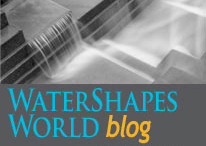Water’s Moving Music

The sound of moving water is universally appealing, be it in nature or built environments. As editor Eric Herman points out here, using sound in a deliberate and thoughtful way, adds a vibrant dimension to the aquatic environment and ultimately the client experience, one that they may not have fully anticipated.
By Eric Herman
Have you ever noticed how many words there are for the sounds that water makes? Terms like splash, babble, trickle, cascade, spill, patter, roil, boil, torrent, and rain, among others, all invoke the noises moving water makes.
Over my many years cover the watershaping design and construction industry, professionals have told me countless times that adding sound to a space is often one of, if not the most appealing aesthetic elements from the client perspective. It’s something that isn’t always anticipated; but, when the installation is finished, the soothing sounds of waterfalls, streams, fountains, spa spillover or vanishing edges introduce an element that is sure to delight the ear.
Personally, I’ve always thought that when sound is used to indicate water’s presence when you can’t yet see it, is one of the more intriguing design moves watershapers and landscape architects can make. When it’s used with intention, the effect can transform the way people experience the space.
Many years ago, I was visiting a project with industry legend, David Tisherman, where he explained how he had used sound create a rewarding destination in a large backyard in an exclusive Los Angeles neighborhood.
The watershape in this case took the form of a gorgeous vanishing edge pool that when viewed from the house and deck drew your eyes toward a wooded backdrop that surrounded the property. Tisherman set up the space so that when you walked down the side of the pool toward the edge, the sound of babbling water filled the air. As he explained, he wanted to use the sound to draw people down a path that led to the far side of the pool, essentially pulling your attention into the landscape.
Tisherman created an edge wall detail with protruding stones that broke up the flow over the edge, creating a complex, yet subtle tapestry of sounds. When arriving at the far end of the pool, you discover the source of the sound in a kind of conceal/reveal design move. Once there, you can look away from the pool into the woods and filtered views, or turn back to the pool and look across the water that reflects the surrounding greenery and the house itself.
In other words, Tisherman used the sound of water to entice you toward a place in the yard with rewarding views. From that moment on, I’ve been hooked on the power of water’s many sounds. Since then, I’ve heard and seen numerous similar accounts from pool builders, fountain specialists and pond installers who use sound for a variety of reasons, including masking nearby traffic noise and creating a sense of privacy.
These days as I walk around my neighborhood past the large estate homes of Palm Springs, I often hear the sound of moving water from over the walls and hedges. I rarely see the source of the sound, but it’s always intriguing to visualize the feature that’s generating the soothing watery music. I’ve enjoyed a similar sensation when hiking in nature, where the sound of water is the first indication of its presence as you move down the trail. Seems that when the music of water is present, I always listen.
Fact is, humans are drawn toward the sound of moving water and are often soothed and rewarded by it. Watershapers who understand this basic tendency are able to harness that interest and use it to add a beautiful aural dimension to their work. In a very tangible sense, there are wonderful possibilities to be found in the sound.









